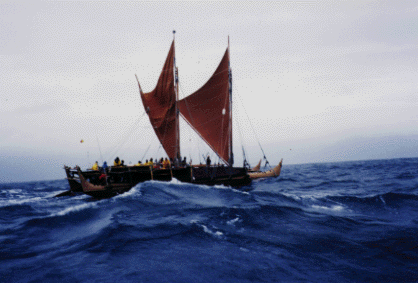The canoes they used
The voyages were all the more remarkable in that they were made in canoes built with tools of stone, bone, and coral. These canoes moved quickly under sail, or by being paddled. They were navigated without instruments, by expert seafarers who depended on their observations of the ocean and sky, and traditional knowledge of the patterns of nature for clues to the direction and location of islands.
The canoe hulls were dug out from tree trunks with adzes. The adzes had heads of sharpened stone, bone or coral, tied to a wooden handle. Sometimes canoes were made from planks sewn together with a cord of coconut fiber twisted into strands and braided for strength. Cracks and seams were sealed with coconut fibers and sap from breadfruit or other trees.
|
|
An outrigger was attached to a single hull for greater stability on the ocean. This meant that it was less likely to capsize in strong winds. For very long trips, two hulls were lashed together with crossbeams and a deck added between the hulls. This made double canoes with more room, that were stable and capable of voyaging long distances. |
|
|
The canoes were paddled when there was no wind and sailed when there was. The sails were woven from coconut or pandanus leaves. These vessels were seaworthy enough to make voyages of over 4,000 kilometres along the longest sea roads of Polynesia, such as the one between Hawai'i and Tahiti. And though these double-hulled canoes had less carrying capacity than the broad-beamed ships of the European explorers, the Polynesian canoes were much faster. One of Captain Cook's crew estimated a Tongan canoe could sail "three miles to our two." |
How did the navigators find the way with no instruments?
Navigators did not have a compass, so they divided the horizon into sixteen parts, taking for the main points the places where the sun rises and sets. They could then tell what direction they were travelling. They noted the direction of the wind, and of the waves, and kept track of changes in the boat's direction all through the day while the sun moved through the sky.
The task was more difficult if the day was cloudy, because the sailing-master has no mark to count from for dividing the horizon into the sixteen parts. If the night was cloudy as well, the sailing-master monitored his course by the wind and swells. Since the wind varies in direction more than the swell does, they used a pennant, made of feathers and bark, to show changes in the wind.
When the night was clear, navigators steered by the stars. They knew the stars which rose and set over not only the islands they were familiar with, but also the harbours in the islands. These sailing masters hit their destinations with as much precision as the most expert navigators of civilized nations could achieve with using compasses and sextants.

Finding islands before they could be seen
To keep track of their position at sea during long sea voyages, the navigators used a system of dead reckoning. They memorized the distance and direction traveled until they arrived at their destination.
|
|
Finding islands before they could actually be seen was also part of the art of navigation. Navigators followed the flight of land-dwelling birds that fished at sea as these birds flew away from the islands in the morning, or returned in the evenings. The navigators also watched for changes in swell patterns, cloud piled up over land, reflections on clouds from lagoons, and drifting land vegetation. |
When European explorers found the islands of Polynesia, the common ancestry of the Polynesians was evidentÑthe inhabitants of widely separated islands looked alike, spoke alike, and had similar cultural practices. Their manufactured products such as fisho oks, trolling lures, adzes, and ornaments also revealed similarities. And they had the same basic stock of domesticated plants and animals. (back to top)